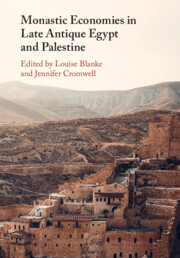Book contents
- Monastic Economies in Late Antique Egypt and Palestine
- Monastic Economies in Late Antique Egypt and Palestine
- Copyright page
- Contents
- Figures
- Tables
- Contributors
- Preface
- 1 The Monastic Economies in Late Antique Egypt and Palestine: Past, Present, and Future
- I. The Monastic Estate
- 2 Monastic Estates in Byzantine Arabia and Palaestina (Fourth–Ninth Centuries)
- 3 Monastic Estates in Transition from Byzantine to Islamic Egypt: Evidence from Aphrodito
- 4 The Naqlun Fathers and Their Business Affairs: Private Assets and Activities of the Monks in a Semi-Anchoritic Community in the Late Antique Fayum
- II. Production and Consumption of Food and Material Goods
- III. Monastic Encounters: Travel, Pilgrimage, and Donations
- Glossary
- Index
- References
4 - The Naqlun Fathers and Their Business Affairs: Private Assets and Activities of the Monks in a Semi-Anchoritic Community in the Late Antique Fayum
from I. - The Monastic Estate
Published online by Cambridge University Press: 14 April 2023
- Monastic Economies in Late Antique Egypt and Palestine
- Monastic Economies in Late Antique Egypt and Palestine
- Copyright page
- Contents
- Figures
- Tables
- Contributors
- Preface
- 1 The Monastic Economies in Late Antique Egypt and Palestine: Past, Present, and Future
- I. The Monastic Estate
- 2 Monastic Estates in Byzantine Arabia and Palaestina (Fourth–Ninth Centuries)
- 3 Monastic Estates in Transition from Byzantine to Islamic Egypt: Evidence from Aphrodito
- 4 The Naqlun Fathers and Their Business Affairs: Private Assets and Activities of the Monks in a Semi-Anchoritic Community in the Late Antique Fayum
- II. Production and Consumption of Food and Material Goods
- III. Monastic Encounters: Travel, Pilgrimage, and Donations
- Glossary
- Index
- References
Summary
Papyrological evidence shows that, in the centuries preceding the Arab conquest of Egypt (fifth to seventh centuries), the monastery at Deir el-Naqlun was home to groups of monks who pursued non-religious activities, possessed private assets, and maintained contact with various ‘worldly’ figures. Among them, we find moneylenders, a creative monk-potter, and a bishop who maintained a network of contacts with officials and elite members. On the other hand, clues as to the overarching organisation of the Naqlun monastery are scant, and the relation of the monks’ individual activity to that of the community as a whole is thus difficult to establish. It is nevertheless clear that managerial structures of an economic character were among the first to emerge within the monastery. Overall, the Naqlun evidence testifies to a model of organisation in which elements of communal life harmoniously combined with a degree of social and economic independence of individual monks.
- Type
- Chapter
- Information
- Monastic Economies in Late Antique Egypt and Palestine , pp. 99 - 126Publisher: Cambridge University PressPrint publication year: 2023

